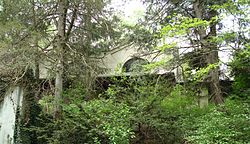Station
In 1912 (left) and 2007 (right)
Since the NYW&B was constructed all at once, one architectural firm, Fellheimer & Long with Allen H. Stem Associated Architects, [4] designed all the stations, platforms and signals for the line. For reasons of continuity, maintenance and appearance, concrete was used as the material for all stations. Built in Renaissance, mission or classic styles, the NYW&B stations are considered among the most well-designed depots in the country. [5] The design of the Quaker Ridge station’s peaked roof was inspired by Manhattan’s Pennsylvania Station. The main structure and covered platforms are of concrete and steel, with tile covering the roof area. The station proper is 52 feet in length, while the platforms represent a covered area of 340 feet, 170 feet on each side.
From an architectural standpoint, the layout of the station was very well-designed. One unusual feature was the below-grade entrance leading to the station house located on an island platform between the northbound and southbound tracks. Commuters on the line were able to enter and leave the building with no problems and the station house protected them from the elements when necessary. The proximity to New York was a strong point of the station and the area, with commuters able to reach the southernmost point of Manhattan within fifty-three minutes or less. [6]
The station was built in 1912 and remained in operation until 1938 when financial distress caused the New York, Westchester & Boston Railway to shut down. The property lay dormant for many years until it was purchased by a local artist in the mid-1950s for conversion to a private residence. The building still retains most of the original details including the two original passenger platforms. [7] The original driveway and turn around for the station has been converted to a dead-end street.
This page is based on this
Wikipedia article Text is available under the
CC BY-SA 4.0 license; additional terms may apply.
Images, videos and audio are available under their respective licenses.




